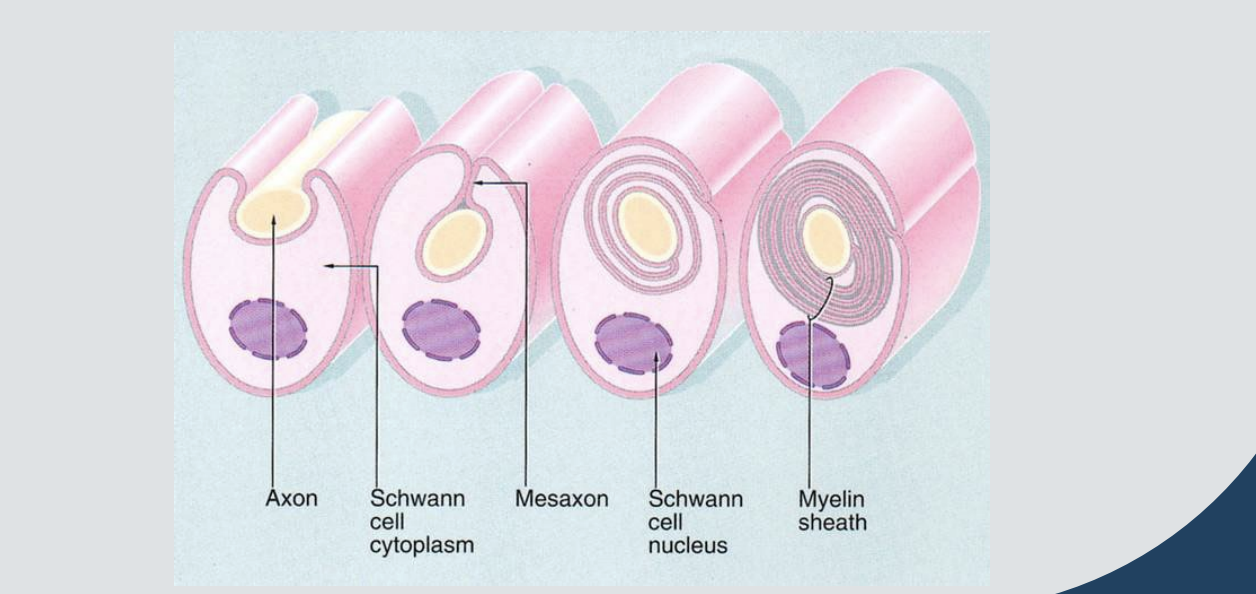Peripheral Nerves and Synapses
1/29
There's no tags or description
Looks like no tags are added yet.
Name | Mastery | Learn | Test | Matching | Spaced |
|---|
No study sessions yet.
30 Terms
What are the two main divisions of the nervous system?
Peripheral Nervous System (PNS) and Central Nervous System (CNS).
What structures are part of the Peripheral Nervous System (PNS)?
Nerves and ganglia.
What structures are part of the Central Nervous System (CNS)?
Brain and spinal cord.
What is the major functional cell of the nervous system?
Neuron.
What are neuroglia?
Support cells of the nervous system.
What is the main role of neurons?
Conduct electrical signals and transmit information.
What is the main role of neuroglia?
Provide support, protection, and nourishment to neurons.
What type of cell is a neuron?
A very large, excitable cell; the building block of nerves and ganglia.
What is the perikaryon (soma) of a neuron?
The cell body of the neuron.
What is the function of dendrites?
Reception of signals from other neurons.
What is the function of the axon?
Transmission of electrical signals to other neurons or effector cells.
What are nerve terminals?
The endpoints of an axon where signals are transmitted to the next cell.
What type of nucleus does a neuron have?
Euchromatic nucleus with a prominent nucleolus.
What is Nissl substance in neurons?
Rough endoplasmic reticulum (rER) and polyribosomes; responsible for protein synthesis.
Name other important organelles found in the neuron cell body.
Mitochondria and Golgi apparatus.
What is the main function of Nissl substance?
Producing proteins needed for neuron function and repair.
What are satellite cells and where are they found?
Neuroglial cells that surround neuron cell bodies.
What is the main function of satellite cells?
Ion exchange and support of neuron cell bodies.
What are Schwann cells and where are they found?
Neuroglial cells that surround axons in the PNS.
What is the main function of Schwann cells?
Contribute to myelin production around axons, aiding in faster signal transmission.

Axon:
The yellow circular structure in the center represents the axon, which transmits nerve impulses.Schwann cell cytoplasm:
Schwann cells (pink structure) start wrapping around the axon. Initially, the axon is just embedded in the Schwann cell.Mesaxon:
The mesaxon is the double layer of Schwann cell plasma membrane that connects the myelin sheath layers to the outer Schwann cell cytoplasm. It represents the initial wrapping.Schwann cell nucleus:
As the Schwann cell continues to wrap, the cytoplasm and nucleus are pushed to the periphery of the cell.Myelin sheath:
With repeated wrapping, multiple concentric layers of Schwann cell membrane form the myelin sheath around the axon. This sheath insulates the axon and greatly increases the speed of impulse conduction.
What is the main function of myelin?
To increase the speed of conduction of nerve impulses.
How does myelin protect neurons?
It acts as an insulator and physically protects the axon.
Does myelin have any nutritional or regenerative roles?
Yes, it may have a nutritional role and can help direct regenerating axons.
What are the two types of axons?
Myelinated and unmyelinated axons.
What characterizes a myelinated axon?
Coated with a fatty myelin sheath
Faster, more efficient nerve impulse conduction
Long-distance fibers (brain, spinal cord, optic nerves)
What characterizes an unmyelinated axon?
Simply cradled in an indentation of a Schwann cell
Slower conduction
Short, local connections (autonomic nervous system, small-diameter axons)
What is a ganglion?
A collection of neuronal cell bodies in the peripheral nervous system.
What is a nerve?
A collection of axons from multiple neurons bound together by connective tissue in the PNS.
What are the connective tissue layers of a nerve?
Endoneurium: surrounds individual axons
Perineurium: surrounds fascicles (bundles of axons)
Epineurium: surrounds the entire nerve